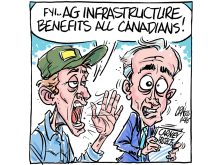It’s a complicated world out there, including the one in which Canadian agricultural producers market their products.
But are they prepared for the shifting landscape? Because shifting it is.
The Organization for Economic Co-operation and Development and the United Nations’ Food and Agriculture Organization recently released a report called Agricultural Outlook 2024-33. One of its conclusions is that China’s role in driving global food and agricultural consumption is waning and will likely be replaced by India and Southeast Asia.
Read Also

High prices see cow-calf producers rushing to incorporate
Farm accountants are reporting a steady stream of cow-calf producers rushing to get their operations incorporated ahead of selling their calves this fall.
Are Canada’s farmers ready for this?
Lucrative markets such as Europe are becoming increasingly difficult to crack, while other markets are more open to buying what our farmers produce, so long as they need it and it doesn’t interfere with their own domestic concerns.
These new realities may require the agriculture sector to focus more on motivated customers and less on reluctant ones.
Some policy decisions, such as the European Union’s new anti-deforestation legislation that will increase scrutiny of soy oil and palm oil, could open new markets for Canadian crops, including canola.
Complicating navigation within the new world map is the increased sensitivity among some of the biggest trading partners who don’t always share Canadian values.
A recent example is the diplomatic firestorm that erupted when the Canadian government blamed the Indian government for the murder of a Canadian citizen on Canadian soil.
How does this country balance the need to speak up for what is right with the need to protect exporters, including farmers?
Then there is the increasing number of hoops created by many trading customers. Does there come a time when some of these hoops aren’t worth jumping through?
Such complications require sophisticated teams that understand the nuances of modern global trade and how to navigate potential pitfalls. This will become increasingly important for Canadian farmers to understand.
Another conclusion in the OECD-FAO report is that future growth in food production will be based on productivity improvements rather than cultivated land and livestock herd expansions.
This is already seen in Canada as farmers continue to embrace new technology to more efficiently boost production.
However, it is also important for farmers to recognize that growing bigger crops from the same plot of land and producing more beef from the same steer is only part of the equation. This food must eventually be sold to customers, many of them living in that new, complicated world.
To do that, this country must continue investing in its ability to optimize competitive advantages.
For the most part, there’s no need to re-invent the wheel. Much of the needed infrastructure is already in place.
Cereals Canada is a case in point.
This organization, which inherited its mandate from the esteemed Canadian International Grains Institute, does an excellent job of promoting the value of Canadian grain around the world.
It ran into trouble recently over plans for a new building, but its mandate remains sound and deserves the entire industry’s continued support.
The same goes for the other commodity organizations that are working in the trenches to promote Canada’s agricultural products.
Farmers are critical at times about how these groups spend their money, but it’s important to remember that advocacy work is ongoing, even if the results aren’t immediately tangible.
The ultimate goal, as the world becomes increasingly complicated, is to open doors and keep them open.
Karen Briere, Bruce Dyck, Barb Glen, Michael Robin, Robin Booker and Laura Rance collaborate in the writing of Western Producer editorials.















